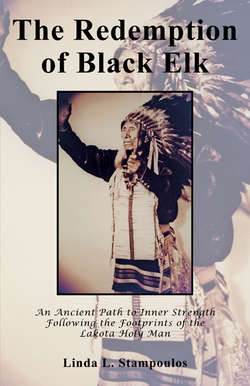Читать книгу The Redemption of Black Elk: An Ancient Path to Inner Strength Following the Footprints of the Lakota Holy Man - Linda L. Stampoulos - Страница 6
На сайте Литреса книга снята с продажи.
ОглавлениеAcknowledgments
First and foremost, I would like to thank the John G. Neihardt Trust for allowing me access to the body of work of Mr. Neihardt which was so vital for my research. I am also grateful for their permission to publish sections of the original transcriptions of Mr. Neihardt’s 1931 Interviews with Black Elk on the Pine Ridge Reservation, and the set of stenographic notes and transcriptions completed by his daughters Enid and Hilda Neihardt.
Most special acknowledgment to the teachings of Mr. Joseph Campbell, whose lifetime of dedication to the study of mythology proved invaluable to this work. As one of the world’s foremost authorities on mythology, Joseph Campbell devoted himself to bringing the mythical sense of the world and its eternal figures back into our everyday consciousness.
My sincere appreciation is given to John C. Knozal, Manuscript Specialist, of the Western Historical Manuscript Collection, University of Missouri-Columbia, Columbia, Missouri for promptly sending me the rolls of microfilm from the John G. Neihardt Special Collection necessary for my research.
My thanks is given to Coi Drummond-Gehrig, Photo Consultant, Western History’s Collection, Denver Public Library for her prompt and excellent service.
Thanks to the National Park Service, Little Bighorn Battlefield National Monument for providing the cover photograph of Black Elk.
Special thanks to Kenneth Shields Jr., a Dakota Sioux from the Bad Temper Bear Band, currently living on the Fort Peck Indian Reservation. He spent several years as Director of the Tribal Archives, and is a contributing author for the tribal newspaper, Wotanin Wowapi. Kenny has been a long-time friend and in addition to his assistance with cultural interpretations, has always offered needed encouragement.
I also express my appreciation to Donovin A. Sprague, an accomplished author, historian, and descendant of Chief Hump and family descendant of Chief Crazy Horse, for his assistance with the Lakota translations. Donovin is also an enrolled tribal member of the Cheyenne River Sioux., the Director of Education at the Crazy Horse Memorial, an instructor at Black Hills State University, Oglala Lakota College, and the Indian University of North America at Crazy Horse Memorial.
Special thanks to Jack Aquila and his staff at Inter-City Press for their imagination and creativity in assisting with the illustrations in this book.
My thanks to John Lamaestra and his staff at Arch-Angel Productions for all the wonderful work in developing and maintaining our website pompanobooks.com.
I would like to thank my husband Scott for his review and word processing assistance. Thanks too, to my son Evan and my daughter-in-law Cathy for their technical contributions to this work.
Thanks and acknowledgement to Cinnamon Bear Alwin, a caring Lenape woman who served as my primary reader and cultural reference.
Recognition goes to Bruce and Lucy Baker, and Herbert and Sylvia Benz for serving as my footprints to my German translator, Rainer Hoeh who shares the understanding and importance of this work. Thanks too for Sylvia and Herbert’s willingness to serve as readers for the German translation.
To my family, the Aschoffs, Schaefers, and Reinharts, as well as my friends who offered patience, understanding, and words of encouragement during the three years of this project I thank you all.
The Meditative Readings and the Great Vision narrative are excerpts from “The 1931 Interviews by John G. Neihardt” published with the permission of the John G. Neihardt Trust and the Western Historical Manuscript Collection, University of Missouri-Columbia, Columbia, MO.
All photographs were provided with the permission of the Western History’s Collection, Denver Public Library.
